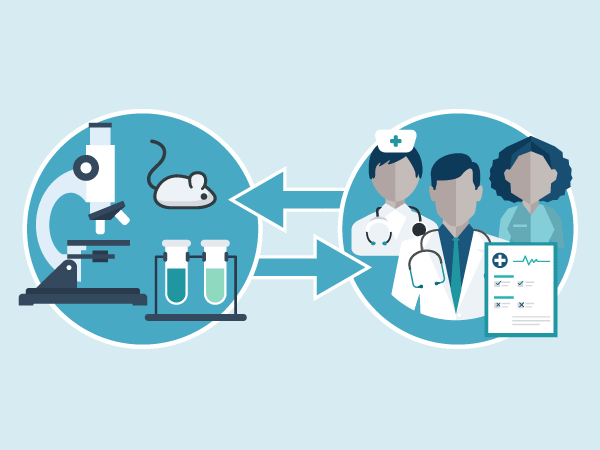
Groundbreaking scientific discovery is always challenging, but so is bringing these advances from the lab to the clinic.
The phrase “bench to bedside” describes a process of taking research results from the laboratory into the clinic so that it can directly benefit patients. It is a short phrase with a short explanation for what is often a very lengthy and complex process.
In its simplest form conducting this sort of translational research involves first conducting basic experiments in the laboratory – or at the bench. Next, pre-clinical research is conducted in animal models. Finally, clinical studies in humans help to move a research concept to the bedside.
“After preclinical models, research moves into phase I trials to make sure it is safe in humans. From phase I, it moves to phase II where it is given to more people and is further evaluated for safety, and, finally, it will be tested in one or more phase III trials,” explained Bryan Haugen, MD, professor of medicine and pathology head, division of endocrinology, metabolism & diabetes and Mary Rossick Kern and Jerome H. Kern Chair in Endocrine Neoplasms Research at the University of Colorado Denver.
This linear process seems very straight forward; however, Dr. Haugen was quick to point out that many of these studies testing drugs or treatment concepts can be negative anywhere along this process, leaving researchers to adjust their theories or start over from scratch. There will be many more research projects at the starting line than the finish line.
Where to Start
Meaningful translational research must start with asking the right question, according to Fredric Kraemer, MD, professor of medicine – endocrinology, gerontology, and metabolism at Stanford University.
“For physician scientists I think research generally starts when you have made an observation in the clinic or a question arises in the clinic that you bring back to the laboratory with the goal that it will eventually return to the clinical setting,” Dr. Kraemer said. “On the other hand, for a basic scientist the focus may be on a basic biological question that, with a lot of foresight, they could say has potential clinical implications, even though they are often not realized for quite some time.”
One example of taking a clinical observation back to the bench for evaluation is the discovery of monoclonal antibody proprotein convertase subtilisin kexin 9 (PCSK9) inhibitors, a new class of drug proven to lower LDL cholesterol levels. Around 2003, scientists in several labs identified PCSK9 and began exploring its role in people with a family history of hypercholesterolemia. Over the next decade, additional studies explored how PCSK9 worked, discovering that PCSK9 inactivates receptors on the cell surface that transport LDL to the liver for metabolism. Next, compounds targeting PCSK9 had to be developed and tested, proving that inhibition of PCSK9 allows these receptors to capture more LDL, removing it from the blood and lowering cholesterol levels.
Just recently, more than a decade later, the FDA approved two PCSK9 inhibitors, evolocumab and alirocumab, for lowering cholesterol in patients where treatment with statins was insufficient.
“The story unfolded over 10 to 15 years, which I think is relatively fast in the world of taking something from bench to bedside,” Dr. Kraemer said.
Timeframe
There is no exact timeline for moving something from bench to bedside, and, although it typically takes anywhere from 10 to 15 years, it can be highly variable.
R. Michael Tuttle, MD, professor of medicine and an endocrinologist at Memorial Sloan Kettering Cancer Center, was a co-author on a phase II study published in The New England Journal of Medicine, that showed that in some patients with advanced thyroid cancer an investigational MEK1 and MEK2 inhibitor selumetinib could reverse resistance to radioiodine – a mainstay of treatment for these patients.
The basis for this publication was the result of several years of work in research labs including that of James A. Fagin, MD, the Chief of Endocrinology at MSKCC, where a link was made between activation of the MAPK pathway and a thyroid cancer cell’s ability to absorb radioiodine. Next, studies were conducted in transgenic mice to show that targeting MEK would restore a tumor’s ability to absorb radioiodine. Development of those pre-clinical models took several years and then the pre-clinical studies took more than a year to complete, Dr. Tuttle said.
Once they were ready to move on to human trials, it took another year or 2 to get the clinical trials designed, approved, and funded. The researchers had to gain approval from two companies involved in the study and the institutional review board. Conducting the trial took a year or two and it took an additional 6 months before any results were ready for publication.
Dr. Tuttle explained that even after all this time, the results published in NEJM are simply proof of principle, opening the door to several additional phase II and III trials that will test MAPK inhibition further with the hope that its use could be “routine clinical practice in a few years.”
According to Dr. Haugen there are some cases where the time from bench to bedside is shorter, for example in HIV research where there are compassionate studies of investigational drugs conducted in patients.
“There are people trying to get away from the linear model, but the big question is always safety and efficacy vs. rapid progression,” Dr. Haugen said.
He also pointed out that a drug’s journey is not always completed once it hits the market. Drugs that make it from bench to bedside may still face difficulties when phase IV trials, or real-world evaluations of a drug, reveal previously unknown adverse events related to its use.
One well known example of this happening was with the non-steroidal anti-inflammatory drug rofecoxib (Vioxx, Merck). Rofecoxib was approved by the FDA for the treatment of osteoarthritis and other acute pain conditions, but was ultimately pulled from the market in 2004 when studies showed increased risk for cardiovascular events, such as myocardial infarction and stroke, after long-term use.
Obstacles to Progress
Researchers will encounter a variety of obstacles on the path from taking a concept from the bench to the clinic. One of the biggest obstacles is asking the right question, according to Dr. Tuttle, who said that there is a large amount of work being done in the laboratory that may not have direct clinical relevance.
“In addition, most people who have big labs do not have big clinical programs and vice versa,” Dr. Tuttle said. “In our study [of selumetinib] we were fortunate that Dr. Fagin had expertise in the lab and a clinical team with a large experience in the treatment of advanced thyroid cancer patients.”
However, not everyone is so fortunate. Dr. Tuttle said that even when researchers are asking the right question, or a relevant question, they do not always have access to the volume or type of patients, or the infrastructure to test their theory.
Another large obstacle on the way from bench to bedside is funding. Physician scientists may also have a clinically relevant research question but may not have the funding to carry out their research, said Dr. Kramer.
Dr. Tuttle agreed, adding, “a research group may have some of the best ideas out there but if they don’t have partnerships with the NIH, a drug company, or philanthropic funding, it will be nearly impossible to move those ideas forward.”
“I think historically, government funding and NIH funding has laid the groundwork for a lot of research that has moved from the bench to bedside, and research and development within pharma has also contributed greatly,” Dr. Kraemer said. “However, in recent years many of the large pharmaceuticals companies probably have less of a focus on basic R&D and more of a focus on trying to get drugs that are further down the pipeline to market.”
Obtaining funding in endocrinology may be particularly challenging as well, Dr. Kraemer added.
“Although diabetes and osteoporosis are huge fields, a lot of what endocrinology deals with has to do with relatively small patient volumes … niche diseases if you will,” Dr. Kraemer said. “It then becomes an issue of profit and benefit for pharmaceutical companies to develop drugs for relatively small markets.”
Finally, Dr. Kraemer pointed out that even if a drug or theory is successfully taken from the lab to the clinic that does not always ensure its success.
“That is just getting it to market,” Dr. Kraemer said. “Getting people to prescribe it or for it to be used appropriately is another issue.”
One example that immediately came to mind for Dr. Kraemer was the use of thiazide diuretics for the treatment of mild or moderate hypertension.
“There were trials of antihypertensive drugs that showed that thiazide diuretics were as effective as many of the more expensive antihypertensive drugs, but were not being incorporated into physician use,” he said.
One study, published in BMC Family Practice in 2012, examined the decision-making process of primary care physicians in Canada regarding hypertension medication choices.3 The study showed that those physicians who more frequently prescribed the more expensive antihypertension medication had misperceptions about the efficacy and safety of diuretics. The researchers wrote that “marketing strategies employed by the pharmaceutical industry and practice experience” appeared to contribute to how the physicians managed their patients with hypertension.
Progress
Young physician scientists who are interested in carrying concepts from bench to bedside should seek out institutions that have true translational research programs, Dr. Tuttle said.
“I visit many programs and they have two wonderful silos: a silo that includes a laboratory and silo that includes the clinic,” Dr. Tuttle said. “They often know each other but there is not a lot of cross talk between them.”
Successful translational research programs must include and encourage members to have meaningful discussions between the lab and the clinic so that clinicians can understand new findings occurring in the lab and those in the lab can understand what the burning clinical issues are.
“It has to be two interested and motivated parties both driving a ship in the same direction,” Dr. Tuttle said.
In addition to improving internal relationships within academia, Dr. Haugen also stressed the importance of outside collaboration as a key component of successful translational research.
“We have to have better partnerships between academia, government agencies and industry,” he said.
In the current environment, a lot of the great ideas in basic science are coming from academic programs, but in many cases, without the help of industry, it would be difficult to move these groundbreaking ideas through to the final phases of research without the help of industry, Dr. Haugen explained.
“The era of ‘family farmer’ researcher, where one person or a small group pushes a research area forward, is ending,” Dr. Haugen said. “Trainees trying to make their way forward in research should avoid that model and work in a more collaborative model with other members of academia and industry.”
Find out more about ways that the National Institutes of Health is supporting translational research.







 © 2025 Mashup Media, LLC, a Formedics Property. All Rights Reserved.
© 2025 Mashup Media, LLC, a Formedics Property. All Rights Reserved.